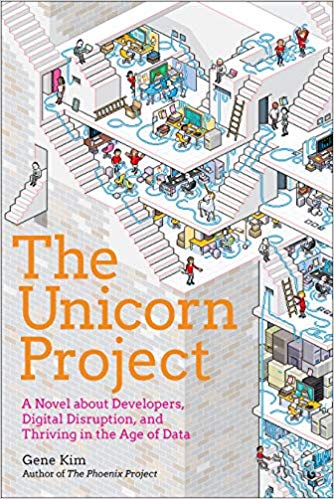The Unicorn Project is written as a quasi-sequel to the widely popular book, The Phoenix Project. This book is written in the third person (whereas the Phoenix Project is written in the first-person point of view of Bill Palmer) and follows the adventures of Maxine, a rockstar developer with years of experience pushing critical code into production. Maxine works on a team that manages some critical control systems for Parts Unlimited, a major auto part manufacturer. However, when a critical system goes down she is left holding the bag and is exiled to the all so dreaded Phoenix Project, an initiative designed to bring Parts Unlimited into the eCommerce age. She arrives there right as Bill Palmer shows up to the scene as well.
Maxine quickly realizes that the Phoenix Project, a multi-team initiative, is far worse than she imagined. Every part of the development process is gridlocked by ticketing systems, non-responsive gatekeepers, and broken build environments. She struggles to even get a build environment running on her local machine. That is until she encounters the Resistance.
The Resistance formed out of the need to work outside the gridlock to push forward the critical work of the company. Maxine gets involved and the team quickly begins working on fixing the broken processes and systems currently hindering effective and efficient development. They are helped along by a mysterious individual named Erik (yep, the same guy from the Phoenix Project book who helps Bill Palmer). Erik teaches the Resistance the Five Ideals of Development. These are:
The Five Ideals
- The First Ideal: Locality and Simplicity
- The Second Ideal: Focus, Flow, and Joy
- The Third Ideal: Improvement of Daily Work
- The Fourth Ideal: Psychological Safety
- The Fifth Ideal: Customer Focus
When these five ideals are correctly focused on in the developer community, development begins to happen at a rapid pace that encourages course correction and providing the absolute best value for the customer. This, in turn, drives growth forward which pays dividends for years to come for a business.
The Unicorn Project also covers the three horizons of growth. The horizons are the pipeline through which new ideas and innovation flows for a company. The Unicorn Project notes that if you’re not growing, you’re declining. New ideas enter a company in the Horizon 3 category. They are prototyped, tested, and evaluated. These are oftentimes referred to as the question mark category. If there is potential for continued growth they graduate to the Horizon 2 category. They are further tested and implemented in the company under a more official status. Finally, these lines enter Horizon 1. These are considered cash cows for a company where market share has been conquered and the fight has been won. However, as with all good ideas turned steady income, Horizon 1’s will eventually move into the decline phase. At this point, the company needs to make sure they have solid Horizon 2 and 3 projects in the pipeline to eventually fill in the roles of Horizon 1 to continue to stimulate growth.
This book is a must-read for anyone who wants to more fully understand the way to sustained growth via effective software development process.
Find the book here: The Unicorn Project
